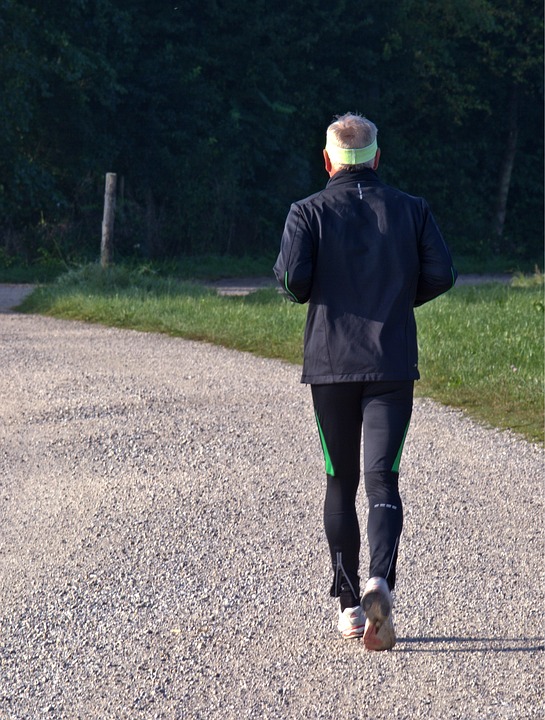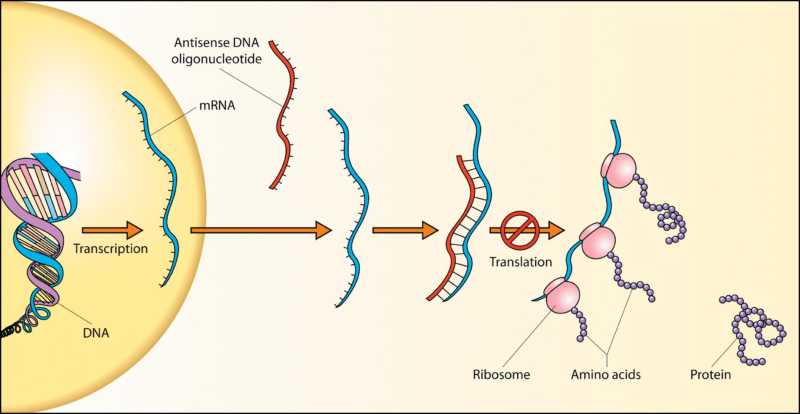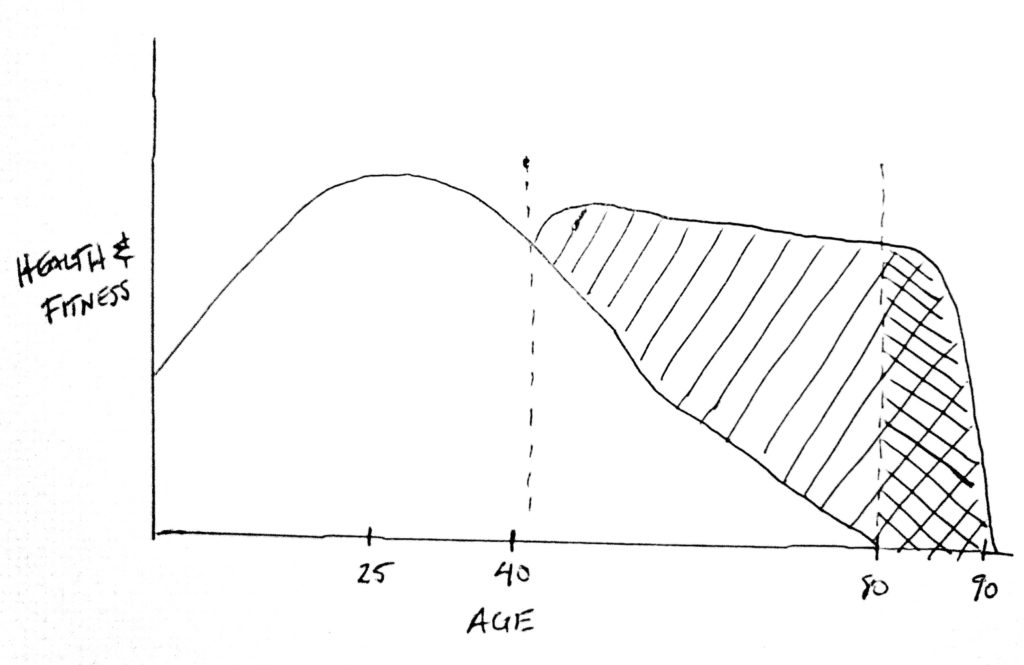The Slow Decline
I admit it, I don’t like getting older. I’m creeping up on my mid-forties. Like most, I thought middle age would never come. I still feel really good, but there are a few tell-tale signs that I’m not the strapping young buck I used to be. Fine print is getting harder to read. My knees will feel a bit sore after a long hike. A couple of years ago, I broke my foot playing a pickup game of basketball. People around me told me that I was too old for that, and I was starting to believe them. On top of that, a body composition analysis, showed I was becoming “skinny fat” (skinny by outward appearance with a flabby belly and internal fat).
My mindset was that this is just what happens to everyone–just go with the flow. I would keep doing my occasional jog around the neighborhood. I figured as long as I was not overweight, I was fine. The problem is that my knees began to hurt when I ran or walked downhill. I started to have pain in my left shoulder when lifting things, and I would get a warning pain in my back if I bent over. Was that just how life was going to be from now on?
One day, I was talking to a friend who is a few years older, who had been having trouble with his back. The last time we had talked, he was worried that he was doomed to chronic pain and/or surgery. When I asked about how he was doing, he said everything had changed. He said he could do things that he thought he would never do again. Now he could hike, snow ski, water ski without pain. He felt stronger and fitter than he had ever been. I asked him what had made the difference. He told me that he had been doing some home workout routines that had changed everything. I was intrigued.
HIIT-Not Your Father’s Jog Around the Track

I grew up in the age of jogging. That’s what everyone did. All of the thinking was that you should do moderate aerobic exercise for a long period (aka steady-state cardio). Sure, if you were young and on a sports team, you would do strength training, but after that, jogging seemed to be the default exercise. The proliferation of treadmills is a testament to how this approach has permeated our culture. Don’t get me wrong, I think jogging is a perfectly good activity. It’s good for your heart. It clears the mind. It deserves a place at the exercise table. However, since it is so repetitive, your muscles can stop responding to it. They get very efficient at that slow, steady movement. There’s not much upper body or core muscle challenge.
Furthermore, recent research has shown that it may not be the most efficient or effective approach to overall fitness–at least not by itself. Since I’m all about optimization, I want to do the things that will give me the best results for the least amount of time–the biggest bang for the buck if you will. Enter HIIT.
High Intensity Interval Training (HIIT) is a system of short duration, high-intensity exercise intervals intermingled with periods of lower intensity active recovery. While the concepts have been around at least back to the 1970s, this approach is being more widely studied and is gaining in popularity. A recent article in the scientific journal Cell Metabolism showed that HIIT type exercise has significant positive affects on the machinery at the cellular level.
Turning Back the Clock
Let’s jump back to your high school biology class to see what’s going on. Recall that your cells are little protein factories, and proteins are the components of muscle and lots of other important tissues and functions. Remember the key players:
- DNA contains the instructions for how to build proteins
- RNA is the mobile transcribed copy of the instructions
- Ribosomes are the structures that “read” the RNA instructions and actually build the proteins from building blocks called amino acids
- Proteins go out and do the function of the cell. One of the most important proteins is the mitochondria (aka the “powerhouse” of the cell)

So the researchers wanted to know what impact different exercises had on these cellular factories. It turns out that HIIT and resistance training (RT) had much greater effects than moderate intensity aerobic exercise.
HIIT boosted the number of ribosomes and mitochondrial proteins. High-intensity regimen actually appeared to reverse the age-related reductions in both mitochondrial function and muscle-building proteins. More mitochondria means more capacity for energy production. More energy production means well, more energy.
If all of this mostly went over your head, no matter. The point is that HIIT and resistance training made older people’s cells look more like younger people’s cells–a fountain of youth!
It actually makes a lot of sense if you think about it. When you do something that really taxes your cells, they get a strong message to ramp things up a notch.
Think of it like when the demand explodes for something like an iPhone. All the phones sell out immediately and there is a long waiting list. Not wanting to miss out on profits, Apple ramps up production capacity to try to catch up to the demand.
This research shows that your body does the same thing. HIIT shouts to your cells, “We need more energy, we need more oxygen utilization, we need more proteins, we need more muscle. Ramp up the production!”
It’s the Intensity, Stupid!
I want to pause here to briefly state that I am not a fanatic or a purist. HIIT may have a very precise definition, which may important if you are a scientist designing an experiment or an elite athlete chasing the last 2 percent gains. There are formal HIIT protocols that use expensive exercise bikes to measure peak performance and effort. I am not going for this kind of rigor. I can reason through the underlying principles and then apply them in a rational way for my benefit. I care more about the spirit of the science rather than the letter.
I’m convinced that the secret sauce of HIIT is the intensity. This is what separates the men from the boys. This is why organized athletics perform at a much higher level. I was on my high school basketball team. At practice, the coach really worked us hard, sometimes to the point of feeling nauseous. It wouldn’t qualify as HIIT to purists out there, but it accomplished the same thing–a significant increase in fitness level in a short amount of time.
The Proof is in the Pudding
I realize that all might sound pretty cute at a cellular level but does it really work? Will you really feel and see the results? I offer you my own and my wife’s personal experience. We’re both in our forties and mostly healthy. Jogging has been a go-to for both of us, but we were inconsistent at best. When we started, be both were carrying around extra weight and we both lacked strength.
About 18 months ago, after talking to my friend, we started a video home workout routine. The routine incorporates cardio, high-intensity exercises, and some resistance training. It is only 25 minutes a day, 5 days a week. The 25 minutes was key for me, since I couldn’t argue that I didn’t have time. It was the perfect amount of time to do in the morning before we got the kids up. I was attracted to something where I could “just push play” and then follow along–no equipment needed. I don’t even put shoes on (which is actually turned out to be good for my feet). We just do the workout watching the TV in our bedroom. The program was designed for “normal people” (i.e. not for fitness fanatics) but with enough challenge to get results. It has a charismatic trainer and a bunch of people on the video that do the routine with you.
My body fat went down, and my muscle mass went up (I went from 18 to 13 percent body fat), and I lost 8 pounds. My muffin top is gone, and my muscles are defined. My wife also had pretty dramatic results (I won’t report the numbers until she gives me permission), so much so that almost all her friends are asking her what she is doing. More than the numbers, the important thing to me is how much better I feel. My knee, shoulder, and back pain are all gone. I bound up the stairs two at a time without even thinking about it. I literally feel 10 years younger! Take a look at the graph below for a visual representation of what I’m talking about.

Adding HITT and resistance training can change the curve
It’s purely a model to make a point. It’s over simplified and an exaggeration, so don’t get your panties in a bunch by trying to over think it. There are lots of things outside of your control that could change it, but I hope you see my point. Instead of passively riding the curve down toward death, you can push your health/fitness back up and ride a pretty steady plateau for a long period until a more rapid decline near death. The area under the second curve represents the increased quality of life you can achieve with daily investment in your fitness. The cross-hatched area is potential additional longevity that results from not having life limiting chronic illness that comes with obesity, high blood pressure, metabolic syndrome, and diabetes. If you plan to enjoy your later years (especially those aiming for early retirement), you can see what a impact this can make.
You Can Do Hard Things
You need a pep talk, because intensity is not easy (that’s the point). If you are like me and my wife, you haven’t done much that has challenged you physically for many years (except for occasional weekend warrior stuff). As I wrote previously, it’s time to make yourself great again. Just as many people are waking up to the need to be financially savvy, it’s time you become physically savvy as well. Succeeding at personal finance and personal fitness both take sacrifice and grit.
It’s time to add intensity to your workout. Maybe it is a “true” HIIT workout, or maybe it is just a workout that pushes you harder than you are used to. If you can watch a TV drama while you workout, it’s probably not intense enough to qualify. If you can go longer than 30 minutes, you probably aren’t working hard enough. Remember, you’re body craves the challenge. High intensity exercise lights up the whole system, body and mind.
One of the impressive side effects of getting in shape is the effect it has on the rest of your life. When you overcome challenges, when you push through pain, it builds your self-esteem and your self-confidence. When you start to your see your body transform, you wonder: what took me so long to do this?
Best Home Workout Video Options
So, now you’re ready to give this a go, here is a rundown of some of the options I’m familiar with:
- Focus T-25 – This is the one we started with 18 months ago. It’s designed for beginners. Shaun-T is the trainer. I like him. He reminds me of Will Smith. There is a modifier person who shows you what to do if you can’t do the regular routine. I started with the regular and my wife started with the modifier. There are three components, Alpha, Beta, and Gamma (Gamma is sold separately) each with 5 or 6 routines, so there are like 15-18 total workouts. Alpha sets your foundation and focuses on different areas, especially your core. We did the Alpha program twice before we moved on to the Beta (we thought it would be much harder, but it really wasn’t). Then we moved on to Gamma, which is more resistance/strength training. It’s 25 minutes a day, 5 days a week and all the routines are mapped out on a calendar. Just push play.
- Insanity Max 30 – Once I’d been through the whole T-25 set several times, I decided to up my game. I wanted to stay with Shaun-T, so I went for this one. This is definitely more advanced, but still limited to 30 minutes. I haven’t worked and sweated like this since high school basketball practice. I am really amazed how hard I’m willing to work by following along. I would never work that hard just following a list of exercises on my own. Now that this is part of our daily routine, it’s just what we do. It’s a 60 day program. Once we completed it, we now mix it up with T-25 and Insanity Max 30.
- Fitness Blenders – These are a popular free option. There are hundreds of workouts on YouTube or on an app. It’s up to you to choose what you should do, so that introduces more decision making (which I try to avoid). The trainers are a nice couple who have been doing this for about 4-5 years. The videos are not as “professional” as the ones above, but that may not matter to you. I like feeling like I am exercising with a group, so this style is not quite as motivating to me.
- Turbulence Training – Another good free option on YouTube. Again, the challenge can be to know how to put together a program that will hit all the right areas.
If you want to try before you buy, there is a BeachBody On Demand, which is like Netflix for workout videos. They have a 30 day free trial, then it’s between $8-$12 per month (depending on how many months you buy at once). This can be a good option if you want to jump around and try a bunch of workout styles. But, since you don’t own the DVDs, if you stop paying, the workouts stop. They also require WiFi, which may not work if you’re traveling. That’s why I’ve gone with the DVDs (then I ripped them to mp4 so I can use my iPad). I can do these for years to come with no additional investment. One trick would be to sign up for the 30 day free trial, decide which one you like, and then cancel the “on demand” and then order the DVDs.
I know there are 10s if not 100s of other options. Have you tried home workouts? Which ones? Did you like them? Did you see results? Post your comments below.



Thanks for the nudge … to get me to move again. Great resources. I tried P90X from Beachbody. It is great but was too much for me. 90 minute intense workouts 7 days per week + diet changes. No thanks!
Then I tried their Power 90. It is Tony Horton’s earlier, easier, shorter workout and that got me moving. The Biggest Loser videos are meant for beginners too.
There are some very short workouts available too such as “Tabata” interval training on YouTube. or “SEVEN” app or on YouTube which is an intense researched 7 min workout. I do that when traveling. It can be done in a hotel with no equipment. If you do it three times you’ve got a decent 20+ min workout.
Congrats to you and your wife on getting more fit. It is too easy to make the other choice – as is evident all around us here in America.
Thanks for sharing your experience. You point out something that I think can be a pitfall for many–doing something that is just too much for where you are. It’s demotivating. Any habit you want to become sustained should start with something small that you can build on. T-25 is within the reach of most, especially with the modifications.
Great article Matt! I started with the 10 min Turbulence Training and have really liked it. I usually alternate between TT and T25.
You make a great point that you can start with something as short as 10 min. The point is to START, right?
As a fitness pro (NSCA) I’m loving these posts ???. High intensity training is great, especially for men looking to lose weight and gain muscle. I’m a huge fan of TRX as well. And women need to get off the cardio machines and lift weights (not crossfit). If you only have a few minutes, work the posterior chain.
Well, if a fitness pro likes my post, I think I’m on the right track. Thanks for the tips. Could you elaborate on your comment about crossfit and women?
Random Crossfit thoughts:
Crossfit depends 100% on the gym and who is running it – there are good ones and there are bad ones. Progressive loading and periodization are very important so if you’re looking for a crossfit gym make sure it’s not just one with random daily WODs.
Olympic lifting has some risks, attention to proper technique and form is important.
Often crossfitters are so excited about fitness as a sport, they forget to go out and use their fitness.
The list of individuals I have recommended crossfit to is very limited, I’m not a huge fan but it has its place.
Women should be lifting. Women should be lifting heavy. It keeps our bodies looking young and it keeps them healthy. Lifting doesn’t bulk, it sculpts. It makes us strong. Women need less time on the cardio machines and more time moving around weight. If you’re a woman and you’re worried about becoming “blockish” that is easily avoidable with the right choice of exercise design for your particular body type and personal needs.